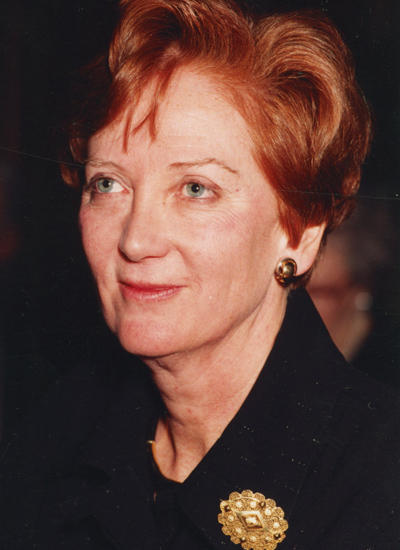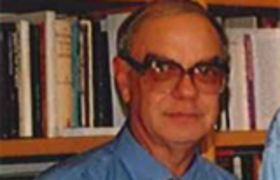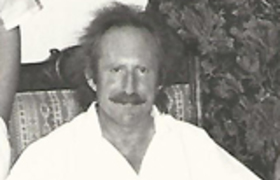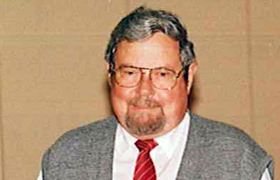Anita Saunders: 1945–2017
22 April 2017 | By Nan Yeld, Ellalou O'Meara and Mary Simons
27 May 1945 – 22 April 2017
Anita Saunders (née Louw) was born in De Aar on 27 May 1945. She had two brothers: Jan, a successful farmer, and Steve, a distinguished physician in Newcastle in the UK.
She went to school in De Aar and then to Hoër Meisieskool Oranje in Bloemfontein for the last two years of her schooling. Academically she was a highly talented student but rejected the conservative values of the school.
Anita came to UCT in the mid-60s to study art and cultural history. She is described by her Fuller Hall flatmates as “a wild, sophisticated, creative rule-breaker”. She worked ferociously hard. Her friends describe her as having a shock of red hair, vivid green eyes, always wearing black clothes and a white smock, and always drawing furiously. She obtained a Diploma of Fine Art from UCT, then went on to a Secondary Teacher’s Diploma (Rhodes University), and a Bachelor of Fine Art (UNISA).
After a brief teaching stint, Anita was appointed as professional officer in the Sculpture and Graphics Department (South African National Gallery), and at the same time was the art critic for the Cape Times. In 1972 she was awarded a scholarship through the Belgium-South African Cultural Agreement and spent 18 months travelling, visiting museums and exhibitions, and attending lectures and classes in History of Art and Film Criticism in Antwerp. On returning to South Africa, she was appointed as educational officer at the South African National Gallery.
Anita was married briefly to the well-known artist, Herman van Nazareth.
Developing and promoting UCT
In 1978, Anita joined the staff of the Department of Cultural History at UCT where she worked as an academic until 1984. Her students and colleagues remember her as passionate about her subject and as an enthusiastic and inspiring teacher. She took a strong interest in the personal and artistic development of those around her, acting as a mentor particularly for postgraduate students and young staff.
Anita married Stuart Saunders (then UCT Vice-Chancellor) on 5 February 1984. In keeping with the mores of the time, she gave up her academic career and took on, wholeheartedly, Stuart’s role of developing, supporting and promoting UCT. It should be noted here that Anita played a transformative role too in Stuart’s own development, broadening his range of interests and knowledge to include the creative arts and the humanities in general.
At Glenara she was a hostess extraordinaire, transfiguring the house into a vibrant, welcoming centre where people could meet, reflect and plan outside of formal structures and roles. She had a real talent for creating an interface between donors, local business people, senior academics and students. What many remember of Glenara during this time is the long, formal dining room with (besides excellent food planned and prepared by Anita), two centres: one more overtly serious and task-focused, the other livelier and often irreverent. It would make an interesting study to determine which approach was more effective for the UCT development/promotion project! Whatever the verdict, it was clear the combination of styles and approaches was highly effective.
Artistic activities resumed
When Stuart and Anita left Glenara they moved to Oranjezicht where Anita could resume her artistic activities. Her artwork was extraordinarily diverse, both technically and in content. She never lost the powerful energy of her first etchings and lithographs, produced in the Michaelis studios in the early 60s.
Six weeks before her death, she painted two bird studies for ceramic pieces. In 2015 she did perfect, small drypoint studies of bees and in 1997 a series of painted plates, which fit into the Wedgwood genre of Eric Ravilious designs.
At the same time, she produced an ongoing body of large sculptural pieces, original in concept: a wall plaque “female angels”, almost portraiture and rich in slightly tongue-in-cheek observation. Bigger still, constructed, almost architectural pieces were also made. Some of these ideas appeared on bridge designs which circled vases and tiles. A playful, brightly coloured giant biographical piece with an acrobatic circus theme celebrates her marriage alongside an enormous dark witch’s goat sculpture.
Another whole set of small sculpted figures emerged when she was nursing her mother (who lived with Anita and Stuart) and she needed to work on a smaller scale, often at the kitchen table. These small 10 to 12 cm sculptures fit into a category of observation by etchers such as Bega or Morandi, photographers such as Lewis Hine and the constructive compositions of William Roberts. These she continued to make until recently and they profoundly, and very quietly, capture moments in time with exceptional three-dimensional skill and colour subtly ‘painted’ with different clays used for modelling different parts. She understood so thoroughly, in the 360 degrees of revolving the small pieces, that one can almost not mourn the fact that her dream of filming them as a moving crowd was not to happen, as she had already used her vocabulary so profoundly.
Literature, friendship and fun
Another of Anita’s great interests was literature. She was a voracious, thoughtful and catholic reader, and an enthusiastic participant, with various groups of friends, in literary meetings and festivals.
Anita understood friendship in a unique way. She was enthusiastic and creative about new friendships and was conscientious, forgiving and supportive of existing relationships. She maintained close one-on-one relationships, with each person having quite specific roles in her life. She set no age barriers for friendship – and indeed, continued acquiring godchildren throughout her life. What made her ‘approach’ extraordinary, though, was the thought and care she gave to bringing her very diverse friendship networks into contact with each other and in the process creating meaningful and interesting connections and bonds. Her legendary dinner (and weekend) parties were underpinned by meticulous planning and the serious agendas of friendship, fun, and of course, delicious food.
Anita has left a legacy of warmth, caring and thoughtfulness. She will be very much missed. This work is licensed under a Creative Commons Attribution-NoDerivatives 4.0 International License.
This work is licensed under a Creative Commons Attribution-NoDerivatives 4.0 International License.
Please view the republishing articles page for more information.










